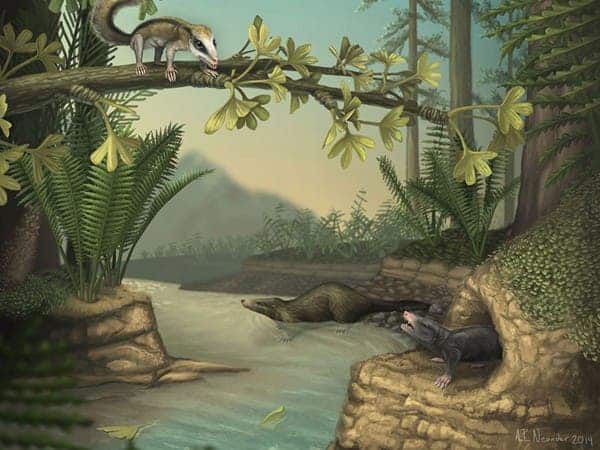Although mammals surfaced only 20 million years after the first dinosaurs evolved, there’s a general consensus that mammals were shadowed and reclusive in the face of dinosaurs, seeing how they were the dominant animals on the planet back then. As such, early mammals are thought to have been mostly nocturnal with minimal interaction with dinosaur environments, occupying very limited ecological niches. This conventional thinking might be toppled by recent findings made by Chinese paleontologists who discovered two highly sophisticated early mammals each at least 160 million years old: the first tree-clinging mammal and the first burrowing mammal. These creatures munched on the same plants dinosaurs did, proving they seemingly coexisted in the same ecological framework.
Mammals and dinosaurs

Early mammals were surprisingly adapted and sophisticated at times when dinosaurs were at a their prime. The image shows the tree clinging Agilodocodon (top), the swimming Castorocauda (in the water) and the burrowing Docofossor (bottom). Image: University of Chicago
Zhe-Xi Luo, a renowned Chinese paleontologist now affiliated with the University of Chicago, first sent waves in the paleontology community when he first reported the discovery in China of a 164-million-year-old docodont named Castorocauda lutrasimilis, which apparently not only swam but might also have eaten fish. This was the first time such a mammal was discovered, an unlikely creature by the dinosaur overlord dictum. Although unknown before the Middle Jurassic, and therefore not among the oldest known mammals, docodonts are considered to be one of the most archaic mammalian groups. Their remains were first discovered more than a century ago in the Late Jurassic Morrison Formation of Wyoming and Colorado, where they are found together with the bones of giant sauropod dinosaurs. Most docodonts are known solely from the dentition, which includes complex, broad cheek teeth. The teeth of these shrew-sized mammals – a cross between a rat and a squirrel – showed they were well adapted for shearing, crushing and grinding plants, but also other foods, as Castorocauda lutrasimilis shows.
Now, Luo and fellow paleontologist Qing-Jin Meng of the Beijing Museum of Natural History published two papers in Science which document two new docodonts. One, called Agilodocodon scansorius, is the earliest known tree-climbing mammal. It had specialized teeth which likely helped it feed on tree sap. The other is 160-million-year-old Docofossor brachydactylus, which judging from its shortened, shovel-like paws is considered the first burrowing mammal.
The early mammal records were found by farmers in the fossil-rich shale outcrops called the Tiaojishan Formation in northeast China.
The delicate fossils were encased in shale slabs. To be sure they wouldn’t ruin them, the paleontologists used CT scans – the same used to image bones and soft tissue in the human body – to image the fossils in high resolution. The images suggest Agilodocodon scansorius (meaning “agile docodon” with a scansorial, or climbing, adaptation) was about 13 centimeters from head to tail and weighed about 27 grams, roughly the size of a house mouse. Docofossor brachydactylus (“Doco” for docodont; “fossor” for fossorial, or digging, adaptations; and “brachydactylus” for short, broad fingers) had a striking resemblance to the modern African golden mole, a burrowing mammal that lives underground. It was about 7 centimeters long and weighed about 16 grams, the size of a small shrew, and had a wide stance typical of burrowing animals, according to Michael Balter writing for Science.
Some 160 million years ago when these mammals lived, dinosaurs were the dominant genus on Earth. Only after they went extinct 65 million years ago did mammals catch ground and really started to diversify, occupying the now empty ecological niches. From rat-sized animals, mammals grew tremendously in size. Examples include Megatherium, a giant ground sloth found in South America which weighed up to four tons and was twenty feet (6m) in length from head to tail.
However, considering how sophisticated these early mammals were, it is likely that the evolutionary groundwork for this surprising diversity and adaptiveness among early mammals was laid down much earlier than researchers suspected. Luo is cautious, however. He’s careful to note that while these fascinating clinging and burrowing mammals seem to counter the stereotypical image of cowering mammals, it is very much true that mammals were only at a fraction of their potential during the dinosaur age.









